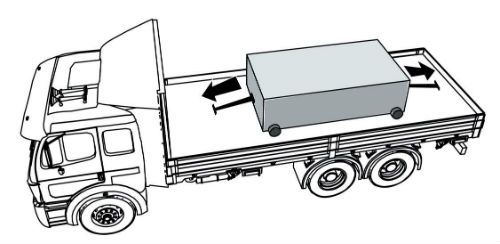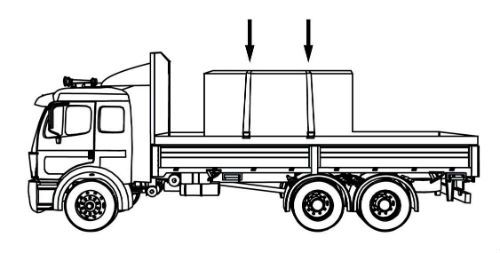CDL Practice Tests: Flatbed Cargo Securement
Choose A Section:
Go!As part of the log packing requirements:
- Logs must be loosely packed.
- Outer bottom logs must be in contact with and rest solidly against bunks, bolsters, stakes, or standards.
- Each inside log on the side of a stack of logs must touch at least two bunks, bolsters, stakes, or standards.
- The center of the highest log on each side or end must be above the top of each stake, bunk, or standard.
Packing requirements
- Logs must be solidly packed.
- Outer bottom logs must be in contact with and rest solidly against bunks, bolsters, stakes, or standards.
-
Each outside log on the side of a stack of logs must touch at least two bunks, bolsters, stakes, or standards. If one end of the log doesn't touch a stake:
- It must rest on other logs in a stable manner.
- It must extend beyond the stake, bunk, bolster, or standard.
- The center of the highest log on each side or end must be below the top of each stake, bunk, or standard.
What is a cab shield?
- A vertical barrier across the front of the deck of a vehicle to prevent forward movement of cargo.
- A structure, device, or another substantial article placed against or around an article to prevent horizontal movement of the article.
- The depression formed between two cylindrical articles when they are laid with their eyes horizontal and parallel against each other.
- A vertical barrier placed directly behind the cab of a tractor to protect the cab in the event cargo should shift forward.
Define 'bolster':
- A vertical barrier across the front of the deck of a vehicle to prevent forward movement of cargo.
- A crosswise load bearing structural component, particularly a part of a log bunk.
- An inflatable bag intended to fill otherwise empty space between articles of cargo, or between articles of cargo and the wall of the vehicle.
- A structure, device, or another substantial article placed against or around an article to prevent horizontal movement of the article.
Bolster:
A crosswise load bearing structural component, particularly a part of a log bunk.
To prevent rolling, how many points of contact are required, at minimum, for a boulder resting on a rounded or partially rounded side?
- 5
- 4
- 2
- 3
Requirements

If the flattest side of the boulder is rounded or partially rounded, place the boulder in a crib made of hardwood fixed to deck of vehicle.
Boulder should rest on both deck and timber, with at least 3 well-separated points of contact that prevent rolling in any direction.
Within the requirements for concrete pipe, which of these requires specific securement methods?
- Concrete pipe loaded cross-wise on a flatbed trailer.
- Concrete pipe that is grouped together into a single rigid article and may not roll.
- Concrete pipe eyes vertical and concrete pipe loaded lengthwise.
- Concrete pipe loaded in a sided vehicle or container.
What is exempt from these specific requirements?
Follow general cargo securement requirements (Section 2) when transporting the following pipe:
- Concrete pipe that is grouped together into a single rigid article and may not roll.
- Concrete pipe loaded in a sided vehicle or container.
- Concrete pipe eyes vertical and concrete pipe loaded lengthwise.
What is covered under these specific requirements?
Any concrete pipe loaded crosswise on a platform trailer or vehicle that is not exempt.
What is the minimum securement requirement for paper rolls with eyes vertical with a width between 1.25 and 1.76 its diameter?
- All of these are required.
- Tiedowns.
- Friction mats alone.
- Banding them together.
Situation #4
- A paper roll or the forwardmost roll(s) in a group of paper rolls is not prevented from tipping or falling forward by vehicle structure or other cargo.
- Paper roll width is more than 1.25 times and less than 1.76 times its diameter.
- Only friction mats are used for forward securement.
Solution #4:
The friction mat alone is adequate. The friction mat allows the roll to slide on the floor without tripping the roll.
An anchor point is defined as:
- The load carrying area of a truck, trailer, or intermodal container.
- Part of the structure, fitting, or attachment on a vehicle or cargo to which a tiedown is attached.
- A vertical barrier across the front of the deck of a vehicle to prevent forward movement of cargo.
- A rail along the side of a vehicle that protects the side of the vehicle from impacts.
Anchor point:
Part of the structure, fitting, or attachment on a vehicle or cargo to which a tiedown is attached.
A chock is defined as:
- A short piece of material, usually wood, nailed to the deck to reinforce blocking.
- A structure, device, or another substantial article placed against or around an article to prevent horizontal movement of the article.
- A tapered or wedge-shaped piece used to secure round articles against rolling.
- A crosswise load bearing structural component, particularly a part of a log bunk.
Chock:
A tapered or wedge-shaped piece used to secure round articles against rolling.
When securing concrete pipe with a diameter up to 45 inches loaded crosswise as a group,lengthwise tiedowns should be either one 1/2 in chain or wire rope, or:
- Two 3/8 inch chains or wire ropes.
- One 3/8 inch chain or wire rope.
- Two 1/4 inch chains or wire ropes.
- Two nylon straps with aggregate WLL of 50% the weight of the load.
As a group
Place lengthwise tiedowns over the group of pipes:
Either one 13 mm (1/2 in) chain or wire rope,
Or two 10 mm (3/8 in) diameter chain or wire rope
When securing concrete pipe over 45 inches loaded crosswise, which direction must the tiedowns on the rear half of the load run?
- Forward
- Rearward
- It doesn't matter.
- Straight up and down.
Requirements for securing the pipe
Secure each pipe with tiedowns through the pipe.
Run at least one tiedown through each pipe in the front half of the load. This includes the middle one if there are an odd number. The tiedown must run rearward at an angle not more than 45° with the horizontal when viewed from the side of the vehicle, whenever practicable.
Run at least one tiedown through each pipe in the rear half of the load. The tiedown must run forward at an angle not more than 45° with the horizontal when viewed from the side of the vehicle, whenever practicable. This holds each pipe firmly in contact with adjacent pipe.
About The Flatbed Cargo Securement CDL Manual
Studying the flatbed cargo securement CDL manual is not a requirement for getting your CDL permit or license. It is required knowledge for flatbed drivers.
Some questions you should be able to answer for flatbed cargo securement:
- What is the minimum Working Load Limit of a tiedown used to secure logs?
- What is the minimum weight of a shipment of paper rolls that would require specific securement requirements?
- When securing concrete pipe over 45 inches loaded crosswise, which direction must the tiedowns on the front half of the load run?
- What is a cab shield?
- When securing concrete pipe over 45 inches loaded crosswise, which direction must the tiedowns on the rear half of the load run?
- What is a dunnage bag?
- Who is responsible for inspecting securing devices and cargo within the first 50 miles?
- How many tiedowns are required on a stack of shortwood loaded crosswise?
- What is the minimum working load limit of each tiedown used to secure crushed or flattened vehicles?
- Define 'bolster'
- What is a hook-lift container?
- When a tiedown is attached directly to the cargo, what is the ideal angle where it attached to the vehicle?
What is a securing device?
Any device specifically manufactured to attach or secure cargo to a vehicle or trailer:
- Synthetic Webbing
- Chain
- Wire rope
- Manila rope
- Synthetic rope
- Steel strapping
- Clamps and latches
- Blocking
- Front-end structure
- Grab hooks
- Binders
- Shackles
- Winches
- Stake pockets
- D-rings
- Webbing ratchet
- Bracing
- Friction mat
What is a tiedown?
A combination of securing devices that forms an assembly that:
- Attaches cargo to, or restrains cargo on a vehicle.
- Is attached to anchor point(s).

Some tiedowns are attached to the cargo and provide direct resistance to restrain the cargo from movement.

Some tie-downs pass over or through the cargo. They create a downward force that increases the effect of friction between the cargo and the deck. This friction restrains the cargo.
 Related Cargo Securement Terms That Every Driver Should Know:
Related Cargo Securement Terms That Every Driver Should Know:
-
Tiedown:
A combination of securing devices which form an assembly that attaches cargo to, or restrains cargo on, a vehicle or trailer, and is attached to anchor point(s).
-
Contained:
Cargo is contained if it fills a sided vehicle, and every article is in contact with or sufficiently close to a wall or other articles so that it cannot shift or tip if those other articles are also unable to shift or tip.
-
Blocking:
A structure, device, or another substantial article placed against or around an article to prevent horizontal movement of the article.
How should tiedowns be attached?
Tiedowns can be used in two ways:
-
Attached to the cargo:
- Tiedowns attached to the vehicle and attached to the cargo.
- Tiedowns attached to the vehicle, pass through or aroundan article of cargo, and then are attached to the vehicle again.
-
Pass over the cargo:
- Tiedowns attached to the vehicle, passed over the cargo, and then attached to the vehicle again.
Tiedown placement:

Place the tiedown as close as possible to the spacer.
Position the tiedowns as symetrically as possible over the length of the article.

Position the tiedowns to preserve the integrity of the article.







 TT On Facebook
TT On Facebook